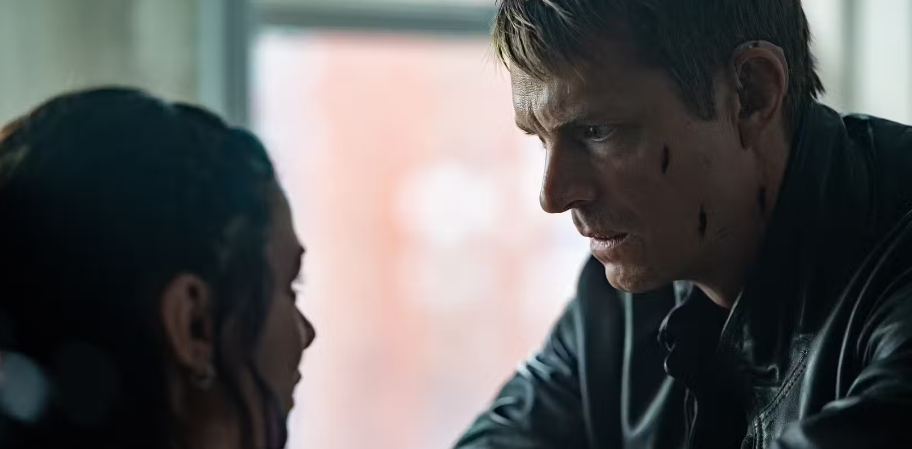The Silent Hour Review: A Gripping Tale of Survival and Suspense
Plot Summary: A Deafening Thriller with High Stakes

In The Silent Hour, directed by Brad Anderson, we follow the intense journey of Boston Detective Frank Shaw (played by Joel Kinnaman) as he navigates life after a devastating injury leaves him with permanent hearing loss. Shaw’s story takes a twist when he’s assigned to interpret for Ava Fremont (Sandra Mae Frank), a deaf witness to a gang murder. Together, they find themselves trapped in a soon-to-be-condemned apartment building with killers on their trail, determined to silence Ava. With no way to hear their attackers and no backup in sight, Shaw and Ava must rely on each other to outwit the relentless threats surrounding them.
Joel Kinnaman Takes on Another Disability in The Silent Hour
Joel Kinnaman’s filmography has recently been filled with roles where his characters face physical impairments, and The Silent Hour is no exception. In last year’s Silent Night, Kinnaman played a man who loses the ability to speak; now, he’s a cop who’s lost his hearing. While Silent Night was full of stylistic action directed by John Woo, The Silent Hour feels closer to something out of the Liam Neeson playbook a gritty, contained thriller set in a single building, where tension builds with each passing moment.

But unlike the stylish and fast-paced Silent Night, The Silent Hour falters in pacing and lacks the energy that its premise promises. Despite a compelling setup a hero who must survive without one of his key senses the film often drags, and the narrative fails to capitalize on the unique concept. With some shining performances, particularly from Sandra Mae Frank, the movie still struggles to maintain momentum and ends up feeling like a missed opportunity.
A World Where Silence Can Be Deadly
The film opens by immersing us into the rich soundscape of Detective Frank Shaw’s life jazz music, the hum of his coffee maker, the ambient sounds of the city. It’s a stark contrast to what comes next, as a life-threatening injury during a suspect chase leaves him partially deaf, and the world goes eerily quiet. This deafening silence becomes a central theme of the movie, echoing Shaw’s own struggles to come to terms with his new reality.

Kinnaman does a solid job portraying a man grappling with his newfound disability, though the character’s obsession with his hearing loss at times feels more like a plot device than genuine character development. Shaw’s hearing impairment is not just a personal struggle, it becomes a metaphor for his disconnect from the world around him his family, his career, and, most importantly, himself.
Despite the heavy focus on this impairment, The Silent Hour doesn’t push the boundaries of what could have been a unique exploration of sensory deprivation in an action-thriller format. Instead, much of the film’s tension stems from more conventional action scenes, and the sense of isolation and danger that should be palpable in a soundless world never quite hits the mark.
Action Without Impact: Missed Opportunities in the Script
Early in the film, we meet Ava Fremont, a witness to a brutal murder who also happens to be deaf. Ava is played by Sandra Mae Frank, an actress who brings authenticity and strength to the role. She isn’t a damsel in distress far from it. In fact, much of the movie’s heart comes from Ava helping Frank come to terms with his own disability. Together, the two form an unlikely partnership, one built on mutual reliance in a world that seems hell-bent on tearing them down.

Unfortunately, once the two characters are cornered in the apartment building, the film turns into a series of repetitive action beats. Shaw’s hearing loss adds a small twist to the formula, but it’s not enough to sustain the tension. We get standard chase sequences, shootouts, and hiding behind corners, but none of it really stands out. At times, Shaw’s inability to hear his enemies is used for comedic effect like when he steps on a piece of bubble wrap but these moments feel out of place in what should be a nail-biting thriller.
It’s frustrating because the premise had so much potential. The claustrophobic setting of a condemned apartment building, the vulnerability of the protagonists, the looming threat of killers who can’t be heard it’s all there. But the script, penned by Dan Hall, doesn’t fully explore these ideas, leaving much of the movie feeling formulaic and predictable. The action never reaches the kinetic heights of The Raid or Dredd, both of which successfully used enclosed spaces to heighten tension and ramp up excitement.
Wasted Talent: A Cast Underserved by the Material
One of the biggest disappointments in The Silent Hour is the underutilization of its cast. Joel Kinnaman, who has proven himself capable of leading action films, seems stuck in a role that doesn’t challenge him. His portrayal of Shaw is competent but lacks the emotional depth or complexity that could have elevated the film. We never truly feel the weight of Shaw’s internal struggle, nor do we connect with his journey in a meaningful way.

Sandra Mae Frank, on the other hand, is the standout. Her performance as Ava is layered and compelling, bringing an authenticity that grounds the film. She shines in moments of vulnerability and strength, showing us a character who is resilient in the face of overwhelming danger. Her chemistry with Kinnaman is solid, but the script doesn’t give their relationship enough time to develop into something more meaningful.
Mark Strong and Mekhi Phifer round out the supporting cast, but they’re largely wasted in one-dimensional roles. Strong, who plays Shaw’s partner Doug Slater, disappears from the movie early on, and Phifer’s villain, Mason Lynch, is a generic, mustache-twirling bad guy who never feels like a legitimate threat. It’s a shame because both actors have the chops to deliver much more than what they’re given here.
Brad Anderson’s Direction: Atmosphere Over Action
Brad Anderson, known for his work on atmospheric films like Session 9 and The Machinist, brings his signature style to The Silent Hour. There are moments where his talent for creating mood and tension shines through, especially in the quieter, more introspective scenes. The way Anderson uses sound or the absence of it is effective in immersing us in Shaw’s world. We experience the muffled, distant sounds as Shaw would, adding an extra layer of suspense to the proceedings.
However, where Anderson excels in atmosphere, he falters in delivering compelling action. The film’s pacing is uneven, with long stretches of downtime punctuated by lacklustre action scenes that never really get the adrenaline pumping. Given the film’s premise, we expect more from the action sequences, but they never quite deliver the punch needed to keep the audience fully engaged.
The Final Verdict: The Silent Hour Lacks Volume
In the end, The Silent Hour is a film that promises more than it delivers. While it has moments of tension and solid performances particularly from Sandra Mae Frank it never fully capitalizes on its intriguing premise. The lack of energy in the action sequences, combined with a script that doesn’t dive deep enough into the unique challenges faced by its characters, leaves the film feeling flat.
For fans of Joel Kinnaman or Brad Anderson, The Silent Hour might be worth a watch, but for those looking for a pulse-pounding thriller, it falls short. It’s not quite bad enough to hate, but it’s not good enough to love either. With a stronger script and more dynamic action, it could have been something special, but as it stands, The Silent Hour is a missed opportunity that leaves its audience wanting more.
If there’s one takeaway, it’s that Sandra Mae Frank deserves bigger and better roles in the future. She’s the beating heart of The Silent Hour, and her performance alone makes the film worth checking out. Just don’t expect it to leave a lasting impression.
Bottom of Form





